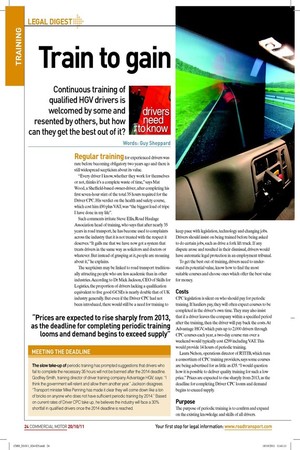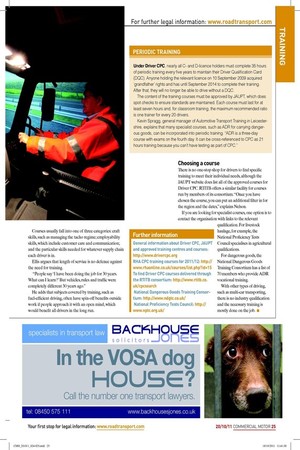Train to gain
Page 16

Page 17

If you've noticed an error in this article please click here to report it so we can fix it.
Continuous training of qualified HGV drivers is welcomed by some and resented by others, but how can they get the best out of it?
Words: Guy Sheppard Regular training for experienced drivers was rare before becoming obligatory two years ago and there is still widespread scepticism about its value.
“Every driver I know, whether they work for themselves or not, thinks it’s a complete waste of time,” says Mat Wood, a Shefield-based owner-driver, after completing his irst seven-hour stint of the total 35 hours required for the Driver CPC. His verdict on the health and safety course, which cost him £90 plus VAT, was “the biggest load of tripe I have done in my life” .
Such comments irritate Steve Ellis, Road Haulage Association head of training, who says that after nearly 35 years in road transport, he has become used to complaints across the industry that it is not treated with the respect it deserves. “It galls me that we have now got a system that treats drivers in the same way as solicitors and doctors or whatever. But instead of grasping at it, people are moaning about it,” he explains.
The scepticism may be linked to road transport traditionally attracting people who are less academic than in other industries. According to Dr Mick Jackson, CEO of Skills for Logistics, the proportion of drivers lacking a qualiication equivalent to ive good GCSEs is nearly double that of UK industry generally. But even if the Driver CPC had not been introduced, there would still be a need for training to keep pace with legislation, technology and changing jobs. Drivers should insist on being trained before being asked to do certain jobs, such as drive a fork lift truck. If any dispute arose and resulted in their dismissal, drivers would have automatic legal protection in an employment tribunal.
To get the best out of training, drivers need to understand its potential value, know how to ind the most suitable courses and choose ones which offer the best value for money.
Costs
CPC legislation is silent on who should pay for periodic training. If hauliers pay, they will often expect courses to be completed in the driver’s own time. They may also insist that if a driver leaves the company within a speciied period after the training, then the driver will pay back the costs. At Advantage HGV, which puts up to 2,000 drivers through CPC courses each year, a two-day course run over a weekend would typically cost £299 including VAT. This would provide 14 hours of periodic training.
Laura Nelson, operations director of RTITB, which runs a consortium of CPC training providers, says some courses are being advertised for as little as £35. “I would question how it is possible to deliver quality training for such a low price.” Prices are expected to rise sharply from 2013, as the deadline for completing Driver CPC looms and demand begins to exceed supply.
Purpose
The purpose of periodic training is to conirm and expand on the existing knowledge and skills of all drivers. Courses usually fall into one of three categories: craft skills, such as managing the tacho regime; employability skills, which include customer care and communication; and the particular skills needed for whatever supply chain each driver is in.
Ellis argues that length of service is no defence against the need for training.
“People say ‘I have been doing the job for 30 years. What can I learn?’ But vehicles, rules and trafic were completely different 30 years ago.” He adds that subjects covered by training, such as fuel-eficient driving, often have spin-off beneits outside work if people approach it with an open mind, which
Strip ad 5 Jun 2011:Backhouse advert 13 would beneit all drivers in the long run.
Choosing a course
There is no one-stop shop for drivers to ind speciic training to meet their individual needs, although the JAUPT website does list all of the approved courses for Driver CPC. RTITB offers a similar facility for courses run by members of its consortium. “Once you have chosen the course, you can put an additional ilter in for the region and the dates,” explains Nelson.
If you are looking for specialist courses, one option is to contact the organisation with links to the relevant qualiication. For livestock haulage, for example, the National Proiciency Tests Council specialises in agricultural qualiications.
For dangerous goods, the National Dangerous Goods Training Consortium has a list of 70 members who provide ADR vocational training.
With other types of driving, such as multi-car transporting, there is no industry qualiication and the necessary training is mostly done on the job. ■










































